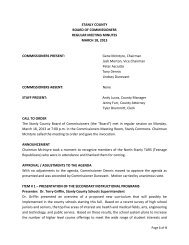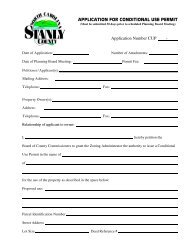Land Use Plan – 2002 - Stanly County, North Carolina
Land Use Plan – 2002 - Stanly County, North Carolina
Land Use Plan – 2002 - Stanly County, North Carolina
You also want an ePaper? Increase the reach of your titles
YUMPU automatically turns print PDFs into web optimized ePapers that Google loves.
STANLY COUNTY<br />
SECTION 4: INFRASTRUCTURE SYSTEMS SERVING THE COUNTY<br />
Introduction<br />
Section 4 of the Phase I report provides a summary of infrastructure serving the county.<br />
Infrastructure examined in this section—including transportation systems, utilities, and<br />
community facilities—all take part in helping defining the future of the county since they so play<br />
such an important role influence development patterns.<br />
Transportation Analysis<br />
Introduction<br />
Roadways<br />
A balanced transportation network should provide a safe and efficient means of travel for both<br />
people and goods. In addition, transportation systems, particularly roadways, contribute<br />
significantly to the patterns of development in any community, be it a city or town, county, or a<br />
region. This section of the <strong>Stanly</strong> <strong>County</strong> <strong>Land</strong> <strong>Use</strong> <strong>Plan</strong> examines existing transportation<br />
systems in <strong>Stanly</strong> <strong>County</strong>. Roadways, bikeways, rail lines, and public transportation will be<br />
studied in this analysis.<br />
<strong>Stanly</strong> <strong>County</strong>’s roadway system is typical of many other counties in central <strong>North</strong> <strong>Carolina</strong>. Most<br />
major thoroughfares—NC 24/27, NC 73, NC 138, NC 740, and U.S. 52—link the county seat,<br />
Albemarle, with outlying rural areas and the central <strong>North</strong> <strong>Carolina</strong> region in a radial roadway<br />
pattern. This radial pattern is repeated to a lesser extent in other population centers of the<br />
county such as Locust/Stanfield, Oakboro, Richfield, and New London.<br />
The remainder of the county road system essentially feeds the major road network by following<br />
the natural topography of the county.<br />
Functional Classification System<br />
According to the American Association of State Highway Transportation Officials (AASHTO),<br />
each roadway is specifically designed and used to serve a particular role—or functional<br />
classification—within the overall roadway network for a community, county, or region. The <strong>North</strong><br />
<strong>Carolina</strong> Department of Transportation (NCDOT) uses the functional classifications identified in<br />
Table 4-1.<br />
In general terms, each roadway classification is based on two design factors:<br />
1. Mobility, or the capacity of a roadway segment to move traffic efficiently; and<br />
2. Accessibility, or the ability of a roadway to provide access to land adjacent to the<br />
thoroughfare.<br />
Each factor is inversely proportional to the other, that is, the capacity of an interstate highway to<br />
accommodate mobility limits its ability to accommodate accessibility to individual properties—<br />
homes, schools, businesses, industrial operations—along a roadway (AASHTO). By looking at<br />
the local classification system an understanding can be gained of the current roadway network,<br />
development patterns, and future opportunities for roadway expansion and development.<br />
The functional classifications system for <strong>Stanly</strong> <strong>County</strong> is illustrated in Figure 4-1.<br />
<strong>Land</strong> <strong>Use</strong> <strong>Plan</strong> 4-1 6/02






